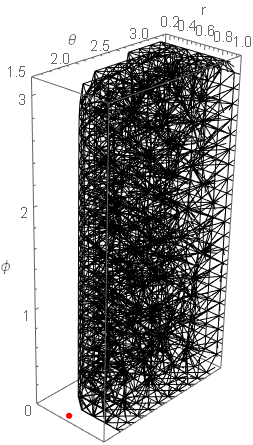Solving the following PDE, defined in the same domain of a previous question:
p = 0.2;
Pe = 20;
<< NDSolve`FEM`
boundaries = {-r +
1/2 (Sqrt[2] Sqrt[Cos[2 \[Theta]] (1 - p)^2 + 2 p + 1 - p^2] +
2 Cos[\[Theta]] (1 - p)),
r - 8, -\[Theta] + Pi/2, \[Theta] - Pi, -\[Phi], \[Phi] - Pi};
\[CapitalOmega] =
ToElementMesh[
ImplicitRegion[
And @@ (# <= 0 & /@ boundaries), {r, \[Theta], \[Phi]}],
"MaxBoundaryCellMeasure" -> 0.04];
Show[\[CapitalOmega][
"Wireframe"["MeshElement" -> "MeshElements", Boxed -> True]],
AxesLabel -> {"r", "\[Theta]", "\[Phi]"},
PlotRange -> {{0.15, 1}, {1.5, 3.16}, {0, 3.16}}]
and
sol = NDSolveValue[{Sin[\[Theta]] Cos[\[Phi]] D[
T[r, \[Theta], \[Phi]], r] + (Cos[\[Theta]] Cos[\[Phi]])/
r D[T[r, \[Theta], \[Phi]], \[Theta]] -
1/r D[T[r, \[Theta], \[Phi]], \[Phi]] ==
1/Pe (1/r^2 D[r^2 D[T[r, \[Theta], \[Phi]], r], r] +
1/(r^2 Sin[\[Theta]])
D[Sin[\[Theta]] D[
T[r, \[Theta], \[Phi]], \[Theta]], \[Theta]] +
1/(r^2 (Sin[\[Theta]])^2)
D[T[r, \[Theta], \[Phi]], {\[Phi], 2}]), {DirichletCondition[
T[r, \[Theta], \[Phi]] == 1., boundaries[[1]] == 0.],
DirichletCondition[T[r, \[Theta], \[Phi]] == 0.,
boundaries[[2]] == 0.]}},
T, {r, \[Theta], \[Phi]} \[Element] \[CapitalOmega]]
I noticed a strange behavior of the solution. For example:
\[Theta]1 = 0.6 Pi;
sol[1/2 (Sqrt[2] Sqrt[Cos[2 \[Theta]1] (1 - p)^2 + 2 p + 1 - p^2] +
2 Cos[\[Theta]1] (1 - p)), \[Theta]1, 0 Pi]
or
sol[0.5, 0.5 Pi, 0 Pi]
give: InterpolatingFunction::dmval: Input value {.....} lies outside the range of data in the interpolating function. Extrapolation will be used, though the input values are inside the domain of the solution. Furthermore, the plot of the solution for small values of \[Phi]] looks fine:
Plot[sol[r, 0.6 Pi, 0.0 Pi], {r, 0.4025, 8}, Frame -> True,
PlotRange -> {{0.15, 8}, {-0.1, 1.2}}]
but
Plot[sol[r, 0.6 Pi, 0.8 Pi], {r, 0.4025, 8}, Frame -> True,
PlotRange -> {{0.15, 8}, {-0.1, 1.2}}]
gives:
Things are even worse with the derivative of the solution, that I need to find the gradient of T on the curved portion of the domain, the final aim being to calculate the flow of the grad of T through the spherical cap. E.g.,
Dr[r_, \[Theta]_, \[Phi]_] = D[sol[r, \[Theta], \[Phi]], r]
Plot[Dr[r, 0.6 Pi, 0.0 Pi], {r, 0.403, 8}, Frame -> True,
PlotRange -> {{0.15, 6}, {-1.6, 0.1}}]
gives:
Things seem to improve if the MaxBoundaryCellMeasure is decreased, at the cost of the computational time however, but the problems on the derivative still remain. I am grateful for any help.







